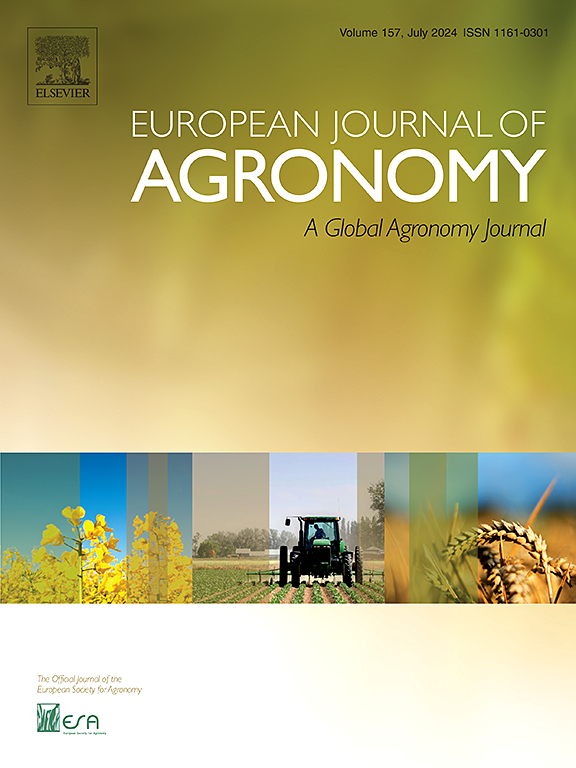基于无人机多光谱图像的光谱特征、纹理特征和小波特征更好地反演水稻穗初形成期氮素营养指数
IF 5.5
1区 农林科学
Q1 AGRONOMY
引用次数: 0
摘要
早穗形成阶段在水稻产量形成和氮素利用效率中起着关键作用。在此阶段快速准确地估算氮素营养指数(NNI)对指导高产水稻的精准施肥至关重要。尽管离散小波变换(DWT)是一种有效的特征提取工具,但其在作物NNI估计中的应用仍未被探索。本研究在江苏省对10个水稻品种和5个施氮水平进行了为期3年的田间试验。利用NNI数据和多光谱无人机(UAV)遥感影像对水稻穗初形成阶段进行了观测。从图像中提取并融合植被指数(VIs)、纹理指数(TIs)和DWT特征变量集。三种特征选择方法分别与四种机器学习算法相结合,建立不同的NNI估计模型,然后评估模型的准确性。结果表明,不同特征集开发的模型总体估计精度顺序为:VIs+TIs+DWT >; VIs+DWT >; VIs+TIs >; VIs >; TIs+DWT。使用VIs+TIs+DWT和VIs+DWT特征集构建的RFECV-RF模型的估计精度均明显高于VIs和VIs+TIs两种现有方法,达到了适合精确定量分析的水平。使用VIs+TIs+DWT特征集构建的模型的性能与偏差比(RPD)显著高于使用VIs+DWT特征集构建的模型。将DWT与VIs和ti相结合,显著提高了水稻穗初萌发期遥感NNI估算的精度,为水稻穗初萌发期氮素状态的精确诊断提供了一种方法。本文章由计算机程序翻译,如有差异,请以英文原文为准。
Better inversion of rice nitrogen nutrition index at early panicle initiation stage using spectral features, texture features, and wavelet features based on UAV multispectral imagery
The early panicle initiation stage plays a pivotal role in rice yield formation and nitrogen use efficiency. Rapid and accurate estimation of the Nitrogen Nutrition Index (NNI) during this stage is essential for guiding precise fertilization in high-yield rice cultivation. Although discrete wavelet transform (DWT) serves as an effective feature extraction tool, its application to crop NNI estimation remains unexplored. In this study, three-year field experiments involving ten rice varieties and five nitrogen application levels were conducted in Jiangsu Province, China. NNI data at the early panicle initiation stage and multispectral Unmanned Aerial Vehicle (UAV) imagery were collected. The sets of vegetation indices (VIs), texture indices (TIs), and DWT feature variables were extracted and fused from the imagery. Three feature selection methods were each combined with four machine learning algorithms to build distinct NNI estimation models, followed by an assessment of model accuracy. The results indicated that the overall estimation accuracy of models developed from different feature sets followed this order: VIs+TIs+DWT > VIs+DWT > VIs+TIs > VIs > TIs+DWT. RFECV-RF models constructed with the VIs+TIs+DWT and VIs+DWT feature sets both exhibited significantly higher estimation accuracy than the two existing methods using VIs and VIs+TIs, reaching a level suitable for precise quantitative analysis. The ratio of performance to deviation (RPD) of the model built with the VIs+TIs+DWT feature set was significantly higher than that of the model using the VIs+DWT feature set. Integrating DWT with VIs and TIs has significantly enhanced the accuracy of remotely sensed NNI estimation during the early panicle initiation stage, providing a method for precise nitrogen status diagnosis in rice at this critical growth phase.
求助全文
通过发布文献求助,成功后即可免费获取论文全文。
去求助
来源期刊

European Journal of Agronomy
农林科学-农艺学
CiteScore
8.30
自引率
7.70%
发文量
187
审稿时长
4.5 months
期刊介绍:
The European Journal of Agronomy, the official journal of the European Society for Agronomy, publishes original research papers reporting experimental and theoretical contributions to field-based agronomy and crop science. The journal will consider research at the field level for agricultural, horticultural and tree crops, that uses comprehensive and explanatory approaches. The EJA covers the following topics:
crop physiology
crop production and management including irrigation, fertilization and soil management
agroclimatology and modelling
plant-soil relationships
crop quality and post-harvest physiology
farming and cropping systems
agroecosystems and the environment
crop-weed interactions and management
organic farming
horticultural crops
papers from the European Society for Agronomy bi-annual meetings
In determining the suitability of submitted articles for publication, particular scrutiny is placed on the degree of novelty and significance of the research and the extent to which it adds to existing knowledge in agronomy.
 求助内容:
求助内容: 应助结果提醒方式:
应助结果提醒方式:


